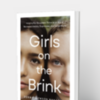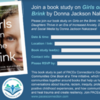"Extremely important" and "very needed" were among the comments of the nearly 100 attendees of the second Connecting Communities One Book at a Time book study webinar when they described Girls on the Brink: Helping Our Daughters Thrive in an Era of Increased Anxiety, Depression, and Social Media.
The book, published on September 13, 2022, was the focus of a conversation between the author, Donna Jackson Nakazawa, and Carey Sipp, PACEs Connection director of strategic partnerships, on October 12, 2022.
 As Nakazawa writes in the introduction of her book, "Depression has long been more prevalent in girls than in boys, but rates of depression in girls have now reached epidemic proportions. One in four adolescent girls reports suffering from symptoms of major depression compared with fewer than one in ten boys. Girls and young women are twice as likely as boys to suffer from anxiety. In 2021, the Centers for Disease Control and Prevention reported that suicide attempts had recently increased 51 percent among girls compared with 4 percent among boys. These statistics cannot be explained by higher rates of awareness or diagnosis. They are real, and they are scary to every parent of every daughter and to anyone who cares about young women."
As Nakazawa writes in the introduction of her book, "Depression has long been more prevalent in girls than in boys, but rates of depression in girls have now reached epidemic proportions. One in four adolescent girls reports suffering from symptoms of major depression compared with fewer than one in ten boys. Girls and young women are twice as likely as boys to suffer from anxiety. In 2021, the Centers for Disease Control and Prevention reported that suicide attempts had recently increased 51 percent among girls compared with 4 percent among boys. These statistics cannot be explained by higher rates of awareness or diagnosis. They are real, and they are scary to every parent of every daughter and to anyone who cares about young women."
She writes further, "In many ways I wrote this book because I felt a moral imperative to close the gap between what experts have learned about growing strong girls in an increasingly threat-laden ear and what parents need to know."
"PACE's Connection's Connecting Communities One Book at a Time initiative was created to bring communities together around books that help us have critical conversations about trauma, racism, inequity, positive and adverse childhood experiences, and the role community plays in preventing and healing trauma and creating resiliency," said Sipp. “The mental health of our young people is a concern in every community in the world right now. We believed this book could bring communities together to address a particularly frightening trend involving the increase in depression and anxiety in girls,” she added.
The conversation between Nakazawa and Sipp covered myriad topics, including the effects of unmitigated stress on the female brain, epigenetics, the complex interactions between estrogen and the female brain during adolescent development, sexism, the evolutionary mismatch between girls’ sensitivity to social cues and today’s social media culture, and the finding that the stress response can be decreased by talking to one trusted caregiver.
Nakazawa was clear that while she sees much to worry about girls’ mental health today, she also has hope. She offers 15 antidotes or “strategies for raising emotionally healthy girls” in the book and spoke about a few of them in the webinar.
Antidotes fall into three categories and include three on “the building blocks of good parent-child connection, and the importance of family connection,” six antidotes for “making her home a safe space,” and six antidotes to “bring in what the wider community can provide.” The interview honed in on at least one antidote from each of the three categories, including making it a good experience when your daughter turns to you, the importance of “wonder”, and encouraging a sense of mastery.
“We need to spread Nakazawa’s research and her message of hope. There is so much we can do to improve the mental health of the girls in our lives” said one participant. Another attendee wrote: “Thank you Donna! You've changed my life for the better—and I've shared your message with many, MANY others…”
“PACEs Connection encourages our members to come together in their communities of friends, colleagues, family members, and fellow parents to start a book study of Girls on the Brink,” said Sipp.”Book studies are terrific ways for communities to address challenges while building the relationships that can help reinforce solutions. We’d love to see many, many communities come together to share Donna’s work and help girls thrive, and have created tools to make this easy for our members to invite their friends, family members, others in their resiliency initiatives, parents of their daughters’ schoolmates, or other groups, to start a book club.”
Here are some resources to help members start their own book studies:
- If you missed the event, you can still view the recording of the Girls on the Brink October 12 webinar! You can also listen to an edited version that we prepared for our History. Culture. Trauma. podcast.
- Nakazawa and her team put together a wonderful Book Club Kit for people interested in leading Girls on the Brink book studies.
- Here’s a handout with tips and items to consider before starting a Girls on the Brink book study.
- You can use this recruiting postcard to invite people to join your book study.
- If you plan to lead a book study, please fill out the Girls on the Brink Book Study Leader Survey so we can keep track of the great work you’re doing!
 “Please join us as we work to Connect Communities One Book at a Time. By reading the book with a group of friends in your book study of Girls on the Brink, you can be part of the solution. All of us can play a part in supporting girls’ mental health,” said Sipp.
“Please join us as we work to Connect Communities One Book at a Time. By reading the book with a group of friends in your book study of Girls on the Brink, you can be part of the solution. All of us can play a part in supporting girls’ mental health,” said Sipp.
Connecting Communities One Book at a Time launched in June with a study of What Happened to You? by Dr. Bruce Perry and Oprah Winfrey, and resulted in more than 130 book clubs forming across the country, according to Sipp.
“We are thrilled to deliver study guides, support, and a connecting place for our members to come together, learn from the authors, share and learn from each other. We’ve even created an invitation leaders can use to invite members of the community to join their book study, to make it as easy as possible for them to get started,” said Sipp.
“We’d love to see this grow and bring unique books and opportunities to our more than 430 geographic and 40 interest-based communities, and hope they’ll use the book studies as ways to grow their communities, too!” she added.
Sipp encourages book study leaders to please register their book study with PACEs Connection, and to answer a few questions to help in planning for the next study. “Also, as we, learn about new resources that could become available in the “Girls on the Brink” book study, having this information helps us share news with book study leaders,” said Sipp.






Comments (1)